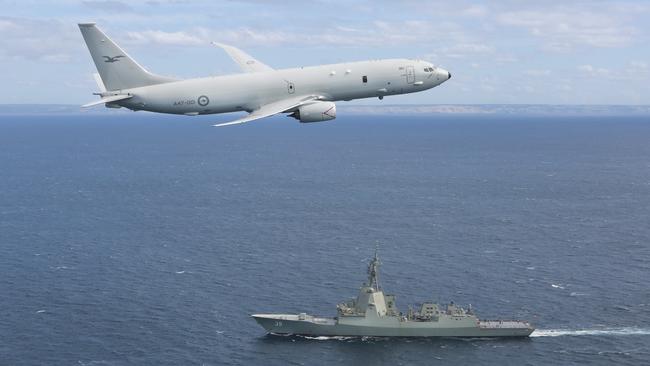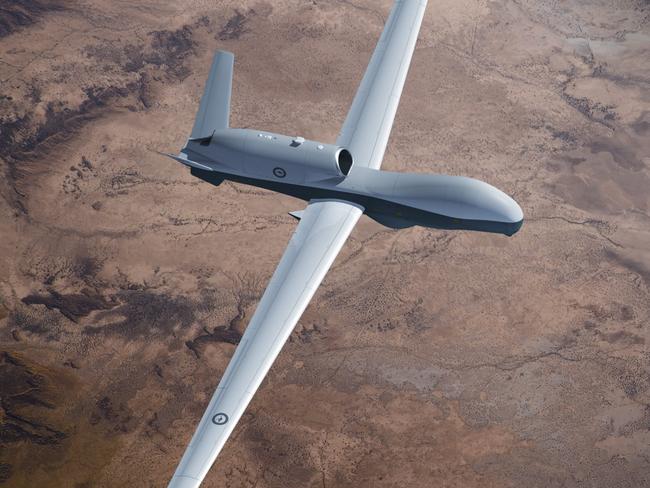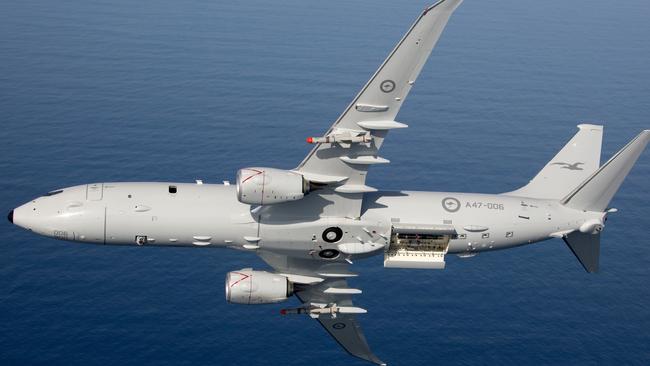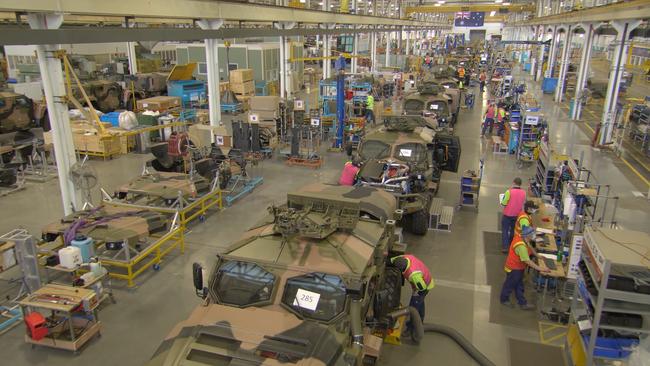Federal Budget 2021: Spy drones, radar jammers among huge Defence delivery
The new financial year will see one of the biggest military defence deliveries in a generation amid a rapidly deteriorating and uncertain region.
National
Don't miss out on the headlines from National. Followed categories will be added to My News.
From spy drones and radar jammers to missile defence shields and underwater weapons systems, the new financial year will see one of the biggest military defence deliveries in a generation.
They are not new acquisitions and in some cases are refresh programs to upgrade or maintain old hardware to keep them going until more modern replacements arrive.
But the 2021-22 Budget papers not only flag a sense of urgency required for the programs to come online amid a rapidly deteriorating and uncertain region but also the push now to recruit up to 1479 military and civilian personnel to staff these stations.

This year another 877 personnel will have to be found over and above current levels and retention/resignation rates, incrementally increasing until 2025.
Fifteen of the 16 ADF aircraft will also this year have to deliver greater flying hours than previous years, the exception being the F/A-18 Super Hornet which is being wound up.
The Defence budget for the year remains unchanged since last year when $270 billion over 10 years was announced as part of the Defence Strategic Update review.
But the budget handed down Tuesday night outlays the mammoth job to match the review’s expectations.

“To implement these objectives, Defence will prioritise our immediate region for the Australian Defence Force’s geographical focus … enhance the lethality of the ADF for high intensity operations that are the most likely and highest priority in relation to Australia’s security,” Defence spells out in its Budget “resources overview”.
The overview reveals COVID-19 led to production and schedule delays of the F-35A joint strike fighter acquisition for Australia but during this next financial year the RAAF is expecting to get 17 more of the jets to bring its total F-35 fleet to 56. Weapons for the aircraft are also set for delivery fast track this year.

During 2021-22 the first three MC-55A Peregrine long range surveillance aircraft airframe modifications will be completed with their operating facility at RAAF Base Edinburgh in South Australia to be completed in quarter two of 2022. The P-8A Poseidon aircraft and supporting elements for intelligence, surveillance reconnaissance, of which 14 have been ordered from the US, will be prepared with configuration for Australian operations.

The soon to be acquired MQ-4C Triton spy drone for intelligence and reconnaissance missions about Australia’s north will continue production with integration testing to ensure they will be able to communicate with ships and other platforms, to begin this year ahead of their delivery.
Airborne electronic attack capabilities for the EA-18G Growler, also procured from the US navy, will undergo test and evaluation at Amberley in Queensland and the Delamere range in the Northern Territory with Defence to also progress through the US Government approvals for the next generation jammers for the aircraft.

On the ground, Army’s Short Range Ground Based Air Defence system procurement with Australian developed radars will be finalised with tests and integration to take place while the project to deliver 1100 Hawkei vehicles will have “introduction into service training” as full production of the Aussie made vehicle gets underway. Special Forces will get the first tranche of kit including leading edge armour, weapons and search and rescue equipment.
Anti-submarine warfare frigates will continue apace with construction to begin on another five Offshore Patrol Vessels by November while the first of the delayed Evolved Cape Class Patrol Boats is scheduled for delivery this December.

Another “key priority” this year will be the much-maligned roll out of the MRH-90 (Taipan) multi-role helicopter to replace the Black Hawk.
“Defence is focused on building a more potent, capable and agile future force to better meet and respond to future challenges while maintaining the preparedness of current capability to meet Government-directed requirements,” Defence said.
VIOLENT THREATS’: WARFARE CASH SPLASH BIGGEST SINCE COLD WAR
Threats to Australia’s “social cohesion” by foreign spies, cyber hackers and organised crime groups has seen one of the biggest ever cash splurges for our law enforcement and intelligence agencies with new funding to better defend our sovereignty.
The Australian Security Intelligence Organisation (ASIO) is the standout winner with $1.3 billion over 10 years to combat what the government has described as “grey zone” warfare by state actors to create social discord through targeted disinformation and interference campaigns.
The domestic spy group has been warned it needed to “adapt quickly” given the evolving nature of the security environment domestically and offshore in our near region including to identify and disrupt the enduring threat of terrorism and violent right wing extremism.
Defence is also committed to expanding its capability to respond to “grey zone activities” largely through working with other government agencies and boosting resilience to cyber attacks.
It had reached its target spend of more than 2 per cent of GDP, the highest level since the Cold War of the early 1990s.

The government has described how under the cover and distraction of COVID-19, “adversaries” had been attempting to exploit Australia’s economic recovery.
“Extremists are trying to encourage social divisions and foreign intelligence services are seeking intelligence about Australia’s key export, technology and research industries,” the Budget papers detail.
“ASIO’s response to these security threats will be critical as Australia emerges from the COVID crisis with security underpinning the recovery.”
Home Affairs Minister Karen Andrews said the “unprecedented long-term investment” would go toward increasing personnel and technology to meet complex operational threats involving unearthing foreign spies and agents of influence particularly targeting Australia’s foreign diaspora for intimidation.
“Coming on top of already record funding for ASIO, this funding boost will ensure that ASIO can significantly enhance its capability to identify and respond to threats,” Ms Andrews said.
ASIO has described Australia as currently facing a heightened threat of foreign espionage and interference with foreign intelligence services “seeking to penetrate government, defence, academia and business to steal classified information, military capabilities, policy plans and sensitive research and innovation”.

China has previously been nominated as particularly active in attempting to steal defence secrets largely from small to medium civilian businesses and contractors in the Australian Defence Force and defence industry supply chain.
There are a raft of other moneys all geared toward protecting our sovereign borders from attacks from within and externally, with the Australian Criminal Intelligence Commission (ACIC) receiving $51.8 million to combat transnational and organised crime and specifically ensure State police forces have shared access to national criminal data.
This year’s budget will also see $42 million to go toward better protecting national critical infrastructure, particularly from cyber attack, while the Australian Border Force’s Airline Liaison Program also received a boost to continue to support international airlines to implement COVID-19 safe travel requirements when borders reopen.
“Without strong national security, the economic recovery and the cohesion of Australian society would be at risk,” Budget 2021 outlines.
“Social cohesion is critical to Australia’s prosperity, stability and competitiveness.”
As part of better improving border security, $464.7 million has been committed to bolster domestic detention capabilities including to the North West Point Immigration Detention Centre on Christmas Island which is where unlawful citizens including criminals set for deportation are held.
$1.2B TO TRAIN ‘NEXT GENERATION’ OF DIGITAL EXPERTS
Australia will splash cash at the growing gap in our cybersecurity defences and artificial intelligence this year, with more than $200 million earmarked for digital training, scholarships, cadetships, grants, and a network of artificial intelligence centres to turn the country into a “leading digital economy and society by 2030”.
The federal budget also revealed big ambitions for the MyGov platform, which will get a $200 million makeover, and details about the $18 million plan to win international investment in Australia’s video game industry.
Federal Treasurer Josh Frydenberg said the tech announcements, part of the government’s $1.2 billion Digital Economy Strategy, were designed to “train the next generation of cybersecurity experts” and encourage the development and use of artificial intelligence in Australia.
“Digital infrastructure and digital skills will be critical for the competitiveness of our economy, creating massive opportunities for growth and jobs,” Mr Frydenberg said.
New cyber defence measures will see $43.8 million invested in the Cyber Security Skills Partnership Innovation Fund to “create a pipeline of cybersecurity professionals that can meet growing demand”.

Another $22.6 million will fund 234 scholarships in emerging technology, while $10.7 million will be set aside to create up to four Digital Skills Cadetship trials.
The initiatives could help address a shortage of cybersecurity professionals in Australia, which AustCyber estimates will reach 17,000 vacant roles by 2026 in both technical and non-technical fields.
CyberCX chief executive John Paitaridis has warned the “dangerous shortage … puts our collective digital privacy infrastructure at risk“.
The federal government will also bet big on artificial intelligence over the next decade, with $53.8 million to be spent on the creation of a National Artificial Intelligence Centre and four AI and Digital Capability Centres.
The network will be designed to establish Australia “a global leader in the development and adoption of responsible AI” and to help small and medium-sized businesses use the technology.

Artificially intelligent investments will include $33.7 million in grants for AI that solves “national challenges,” $12 million for community and business grants for AI to help regional areas, and an additional $24.7 million to establish a Next Generation AI Graduates Program.
More digital spending will see $200 million spent on “a new, enhanced MyGov platform“ over just two years, in a move designed to make the platform a one-stop shop for government services, and $421.6 million to support My Health Record and the Australian Digital Health Agency.
Details about the federal government’s tax incentive for video game development were also revealed in the budget, revealing that eligible games “must not have gambling elements” and must cost at least $500,000.
The long-awaited scheme, which will be launched in July next year, will offer a 30 per cent refundable tax offset, though exact criteria will be set after consultation with the industry.
Interactive Games and Entertainment Association president Ron Curry said the tax incentive would “underpin a new wave of Australian video game development” and could see locals claim a bigger chunk of the lucrative $250 billion global video game market.
TECH GIANTS AND AUSSIE MEDIA
Google and Facebook will share millions of dollars with Australian media outlets for using their content this year.

And the Australian Communications and Media Authority has been tapped to police the world-first scheme.
ACMA will receive $4.2 million to oversee the News Media and Digital Platforms Mandatory Bargaining Code over the next three years, with its role “including registering news businesses and maintaining a register of arbitrators”.
The US tech giants have signed deals with several Australia media outlets since the code became law in February, including Seven West Media, Nine Entertainment, News Corp and Junkee Media.
Country Press Australia president Bruce Ellen has criticised Facebook for failing to strike deals with smaller players, however, and negotiations continue with it and Guardian Australia.
Originally published as Federal Budget 2021: Spy drones, radar jammers among huge Defence delivery



